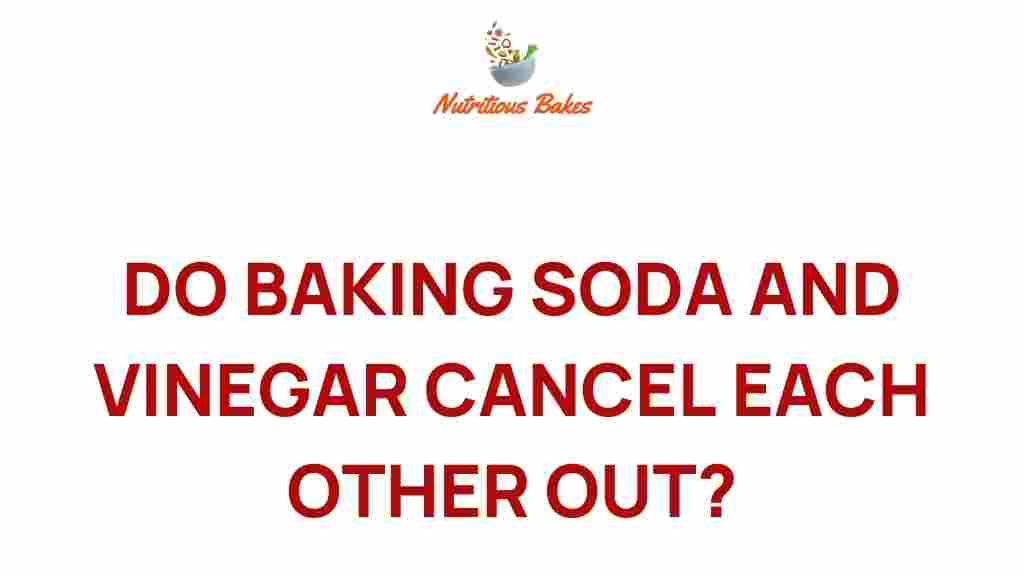The Surprising Science: Do Baking Soda and Vinegar Cancel Each Other Out?
Baking soda and vinegar are two common household items that many people use for various purposes, from cooking to cleaning. They are often touted for their effectiveness in kitchen science experiments and household hacks. However, there seems to be a common misconception that these two substances cancel each other out. In this article, we will delve into the chemistry behind baking soda and vinegar, explore their reactions, and provide some cooking tips and culinary experiments you can try at home.
Understanding the Chemistry of Baking Soda and Vinegar
To understand whether baking soda and vinegar cancel each other out, we first need to look at the chemistry involved. Baking soda, or sodium bicarbonate (NaHCO₃), is a weak alkaline compound that reacts with acids. Vinegar, on the other hand, contains acetic acid (CH₃COOH) and is acidic in nature. When these two substances are combined, a chemical reaction occurs.
The primary reaction can be summarized as follows:
NaHCO₃ + CH₃COOH → CO₂ + H₂O + NaCH₃COO
This reaction produces carbon dioxide gas (CO₂), water (H₂O), and sodium acetate (NaCH₃COO). The fizzing and bubbling you see when you mix baking soda and vinegar is due to the release of carbon dioxide gas.
Do They Cancel Each Other Out?
The short answer is no; baking soda and vinegar do not cancel each other out. While they neutralize each other chemically, this does not mean they lose all their properties. Instead, they undergo a reaction that creates new substances. The carbon dioxide produced can be harnessed for various culinary experiments or even household cleaning hacks.
Culinary Experiments with Baking Soda and Vinegar
If you’re curious about how baking soda and vinegar can work together in the kitchen, here are some fun culinary experiments and cooking tips:
- Volcano Cake: Create a fun dessert that erupts with foam! Mix baking soda into your cake batter and use vinegar as part of your frosting for a surprise eruption effect.
- Fluffy Pancakes: Add baking soda to your pancake mix to enhance fluffiness. You can also use vinegar as a leavening agent when combined with milk.
- Pickling: Use vinegar as a brine for pickling vegetables, while baking soda can be used to neutralize excess acidity if needed.
Household Hacks with Baking Soda and Vinegar
Beyond the kitchen, baking soda and vinegar can be powerful allies in your home. Here are some household hacks that utilize their chemistry:
- Drain Cleaner: Pour baking soda down your drain followed by vinegar to clear minor clogs. The reaction helps to break down grime.
- Deodorizer: Use a mixture of baking soda and vinegar to deodorize your refrigerator or other areas of your home.
- Stain Remover: Create a paste using baking soda and water, apply it to stains, and then spritz with vinegar for a deeper clean.
Step-by-Step Process for a Fun Science Experiment
Let’s conduct a simple kitchen science experiment using baking soda and vinegar!
Materials Needed:
- Baking soda
- Vinegar
- A clear plastic bottle
- A balloon
- A funnel (optional)
Instructions:
- Using the funnel, add 2 tablespoons of baking soda into the balloon.
- Fill the plastic bottle with about 1/2 cup of vinegar.
- Carefully stretch the opening of the balloon over the mouth of the bottle without letting the baking soda fall in yet.
- Once ready, lift the balloon to allow the baking soda to fall into the vinegar.
- Watch the reaction! The balloon will inflate as carbon dioxide is produced.
This experiment not only shows the reaction between baking soda and vinegar but also provides a visual demonstration of gas production—a great educational activity for kids!
Troubleshooting Tips
When conducting your experiments or using baking soda and vinegar for cooking, you might encounter some issues. Here are some troubleshooting tips:
- Too Much Fizz: If the reaction is too vigorous, try reducing the amount of baking soda or vinegar used.
- Insufficient Reaction: Ensure that both substances are fresh. Old baking soda or vinegar may not react as effectively.
- Odor Issues: If you’re using baking soda and vinegar for cleaning and encounter a lingering smell, rinse the area with water after the reaction.
Food Science: The Role of Baking Soda and Vinegar in Cooking
Baking soda and vinegar play crucial roles in food science. Baking soda acts as a leavening agent, helping baked goods rise. It can also enhance browning due to the Maillard reaction. Vinegar contributes acidity, which can brighten flavors or tenderize meats, making it a valuable ingredient in marinades.
Understanding the role each of these ingredients plays in your cooking can help you create better dishes. For additional insights into food science, check out this informative resource.
Conclusion
In conclusion, baking soda and vinegar do not cancel each other out; rather, they participate in a fascinating chemical reaction that produces carbon dioxide, water, and sodium acetate. Whether you’re using them for culinary experiments, cooking tips, or household hacks, understanding their chemistry can enhance your kitchen science adventures.
So, the next time you reach for baking soda and vinegar, remember that you’re not just mixing ingredients; you’re engaging in a little bit of science right in your kitchen!
This article is in the category Tips and created by NutritiousBakes Team
